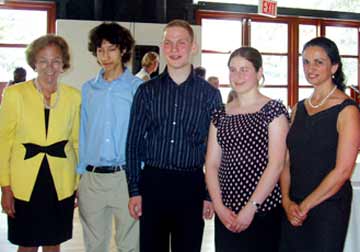 |
(L-R)
Dr. Charlotte Frank, Jedtsada Laucharoen (Winner Physics,
Horace Mann School, The Bronx); Michael Vishnevetsky
(Winner Medicine, Midwood High School at Brooklyn College,
Brooklyn); Alina Fradlis (Winner Chemistry, Staten Island
Technical High School, Staten Island); Dr. Julia Rankin |
A Monumental Tribute to
American Nobelist & Student Essay Winners
By Joan Baum, Ph.D.
|
Ambassador
Liv Mørch Finborud, Consul General of Norway & Ambassador
Kjell Anneling, Consul General of Sweden |
|
Deputy
Chancellor Carmen Fariña |
Theodore Roosevelt
Park—a lovely oasis of green on the
north side of the Museum of Natural History at 81st Street —named
for the President who was also the first American to be awarded
a Nobel Prize (Peace, 1906)—recently was the scene of
a joyous and significant double celebration: a tribute to the
seven 2004 American Nobel Laureates whose names had just been
inscribed on the columnar Nobel Monument in the park, and an
awards ceremony for the winners of the first Laureates of Tomorrow
Nobel Essay Contest. The competition, open to all New York
City High School juniors, was the creation of the Consulate
General of Sweden in New York, in conjunction with the New
York Academy of Sciences, the New York City Department of Education
(DOE) and The City University of New York, and is supported
by, among others, Macmillan/McGraw Hill, Glencoe/McGraw Hill
and the New York Hall of Science. Though the day was hot and
the topic even hotter—the need to advance scientific
literacy and encourage scientific achievement in the city’s
schools—presenters and student recipients could not have
been more cool in their mix of modesty and confidence.
What a scene—in all senses of the word: the trees, which
keynote speaker Nobelist Richard Axel (Physiology/ Medicine)
delighted in pointing out—lindens, elms, ginkos, horse
chestnuts, oaks—were European and American, symbolic
of the old and new worlds coming together on American soil.
Indeed, since the inception of the Stockholm-based awards in
1901, Americans have garnered 284 Nobels, their names engraved
onto the mica-inflected, reddish stone Nobel Monument, elegant
in its soaring vertical simplicity. The seven new Nobelists
are: David J. Gross (Physics), H. David Politzer (Physics),
Frank A. Wilczek (Physics), Irwin A. Rose (Chemistry) Richard
Axel (Medicine), Linda B. Buck (Medicine) and Edward C. Prescott
(Economics).
The setting was also
significant, as a number of speakers and audience members
noted, because New York City is the center of scientific
enterprise, and the students who were honored that day could
well be Nobelists of the future in physics, chemistry and
medicine/physiology. After all, the monument, which was inaugurated
by the Mayor and by the then Prime Minister of Sweden in
October 2003 leaves ample room for more names. Of course,
the camera moments for 1st, 2nd and 3rd place student winners,
their parents and teachers, and for leading members of the
DOE who attended the ceremony, including Dr. Julia A. Rankin,
Director of Science and Deputy Chancellor Carmen Farina,
were the presentations. The contest, open to juniors attending
public, private or parochial high schools in the city, requires
each contestant to write about the significance of a Nobelist’s
work in physics, chemistry or medicine on science itself and
also on society. The first place winners—Jedtsada Laucharoen,
from Horace Mann, who wrote about Physics Nobelist Heike Kamerlingh
Onnes; Alina Fradlis, from Staten Island Technical High School,
who wrote about Chemistry Nobelist Paul Berg; and Michael Vishnevetsky,
from Midwood High School, who wrote about Medicine Nobelist
Gunter Blobel—will each enjoy an all-expense paid trip
to Stockholm to attend the Nobel Prize ceremonies in December,
courtesy of The Hon. Kjell Anneling, Consul General of Sweden
in New York.
The Ambassador, a charming,
witty, and gracious man, eager to credit his staff—Anneli Heinsjö and Helén
Daun Rosengren, in particular—with coming up with the
Nobel Laureate Essay idea in the first place, also noted the
close cooperation between his office and that of the Norwegian
Consul General, Liv Finborud, also present for the awards.
Naturally, the Ambassador is delighted at having his office
participate in this new science initiative, but—he winks
and smiles—the essay contest also provides a stellar
opportunity for American students to learn about Sweden, its
history, its involvement in the Nobel Prizes, and its culture,
a small part of which was on beautiful display that day when
the Swedish Vocal Ensemble, a quartet of a cappella voices
led by Christina Nylund, performed a select number of Swedish
songs.
Though this first contest drew only 19 schools into the competition,
even that number is amazing considering the launch of the initiative
only 9 months ago and the usual pace of bureaucracy. But now
that the idea is off the ground, its impact in the schools
is likely to be, as Alfred Nobel might have said if he knew
American slang, dynamite.#
